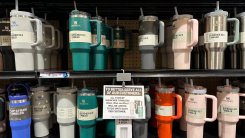Don’t Lead-Test Your Stanley Cup Until You Read This

Pacific Market International’s Stanley line of insulated cups have become a trendy status symbol for TikTokers and their young fans, but when anything gets this popular, there is always a backlash. Lately, social media posts about Stanley cups (no relation to the hockey trophy) focus on the rumors—now confirmed—that they contain lead. How concerned should you be about that?
Why lead is a concern
Lead is a metal that can cause damage to the brain and nervous system, especially in children. This is why lead was banned from residential house paint in 1978. In turn, that is why your pediatrician asks at well-baby checkups how old a house you live in. Besides paint, children can also be exposed to lead through water and soil. Less commonly, lead may also be found in toys or household objects.
It’s routine to test toddlers for lead in their blood, which tells you whether they’re being exposed on a regular basis. Otherwise, the main way to deal with the risk of lead is to minimize your exposure. If you have lead paint in your house, for example, you would want to paint over it completely with a non-lead paint to seal it in. And right now, many municipalities in the U.S. are replacing lead pipes used in their water systems.
Where is the lead in a Stanley cup?
Stanley states on their website that lead is used in a small sealing pellet at the bottom of the cup. If you look at the bottom of your Stanley cup, there should be a small circle, the same color as the rest of the bottom of the cup. That covers the pellet.
To be clear:
-
The interior, which comes in contact with the drink, does not contain lead.
-
The exterior, which you touch as you’re holding the cup, does not contain lead.
-
The only way to be exposed to the lead in the sealing pellet is if the cup is damaged and that circle at the bottom of the cup comes off.
So if you were worried that you’re pouring your coffee onto a lead-infused surface, relax—that’s not what’s being talked about here. That said, if you have a banged-up Stanley cup that is missing the covering circle at the bottom, you may want to do something about it.
What should I do if the circle comes off the bottom of my Stanley cup?
This shouldn’t happen—which means that if it does, Stanley considers it a warranty-eligible repair. Use this form to submit a warranty claim. The company currently says they’re getting a lot of requests, possibly because of the attention lead concerns have received on social media.
How can I test my Stanley cup for lead?
You can buy test swabs that say they can detect lead, and TikToks featuring these swabs have become popular. But these tests use swabs that are intended for testing lead paint. These swabs aren’t necessarily accurate when used on metal, like the interior of your Stanley cup. (Even if it says they can test “metal,” the fine print usually says that they are intended for painted metal.)
But more importantly: lead testing swabs aren’t very accurate. The EPA recognizes three brands of lead testing swabs as being able to tell you when a surface does not contain a certain level of lead. The EPA says that there are no lead test kits that can reliably tell you when a surface does contain lead. The false positive rate is extremely high, up to 98% for some lead-free materials in testing.
Most people who are rubbing swabs on their Stanley cups (or other insulated tumblers) are seeing them come up negative. But if they show a positive result, that doesn’t necessarily mean there is lead on the surface of the cup. If you’re going to be so cautious about lead that you don’t believe Stanley when the manufacturer tells you that the stainless steel interior does not contain lead, you may just want to use a glass or plastic container. (Switching to another brand of metal cup isn’t necessarily going to be the answer—Stanley is not the only brand to use lead in the manufacturing process.)



